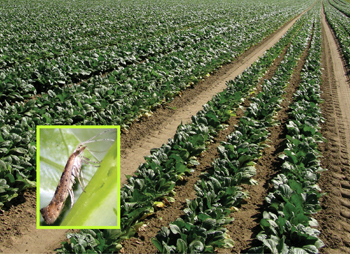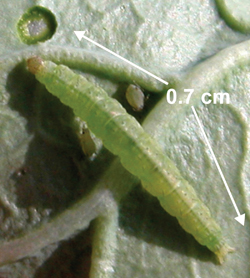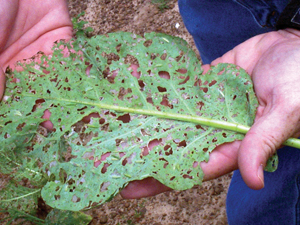
Diamondback Moth (DBM) Resistance
 Diamondback moth larva feeding on cabbage leaf.
Diamondback moth larva feeding on cabbage leaf.The diamondback moth, Plutella xylostella L., (DBM) is a common lepidopteran pest of cole crops including cabbage, collards, turnip greens, mustard greens, broccoli, cauliflower and other Brassica species. This insect has a long history of becoming resistant to insecticides beginning with DDT in 1953. Since then, DBM has become resistant to each new class of insecticide arriving to the market whenever those insecticides were used intensively and repeatedly to control a DBM population. The more effective the new insecticide, the more rapidly selection for resistance seems to occur. Fortunately, we understand much more about this selection process. Typically, a specific insecticide mode of action (MOA) will select for DBM individuals that can tolerate other insecticides with the same MOA. These MOAs are conveniently categorized by IRAC group numbers, so if your DBM population is not controlled by an insecticide, you should not use an insecticide in the same IRAC group at that time. Prevention is critical. To delay the onset of resistance follow the practices listed under “Management Tips.” Even if resistance is detected in an area, these tips can inhibit its spread and preserve insecticide effectiveness.
Delaying Resistance
A rotation program taking advantage of efficacious insecticides with differing modes of action (MOAs) is strongly encouraged to delay the selection process. Where possible, consider using any single MOA only once per crop season. Long residual soil applied insecticides, such as occur in IRAC Group 28, can pose additional challenges. If a single soil application of a systemic Group 28 insecticide provides control for more than half of the crop cycle, do not use it in the next crop. If soil-applied Group 28 insecticides were used in the previous crop, only use foliarly-applied group 28 insecticides on the second half of the crop. Also, maximize spray efficiency by using an adjuvant with foliar Group 28 applications to assist in spray deposition and penetration.
Managing Resistance
 Diamondback moth, Plutella xylostella L., damage to a leaf of collard greens with numberous spinosad-resistant larvae and pupae on the leaf.
Diamondback moth, Plutella xylostella L., damage to a leaf of collard greens with numberous spinosad-resistant larvae and pupae on the leaf.Once resistance is detected in an area, there are effective ways to manage your DBM population even if some portion of the population does not respond to a particular MOA at that time. Allowing a refuge of susceptible DBM individuals can help to dilute the resistant population. Using a treatment threshold (e.g., 0.1-0.3 larvae per plant) will also reduce the spray frequency and selection for resistance. With an effective rotation schedule, an insecticide with a different MOA can be used to lower the number of resistant individuals in the field. Preferred rotation plans base the timing of rotations on the generation time of the pest. Where distinct generations do not occur, windows of the same duration as a pest generation should be used for rotation timing. Insecticides with similar MOAs should not be used on successive generations or within successive use windows. Within a generation or use window, a MOA should not be used more than twice (preferably once).
An example resistance management program for Georgia (below) illustrates how for the cabbage stages transplant to the 12-leaf stage, cupping, and heading to harvest, the use of insecticides by IRAC groups can be segregated to minimize selection on successive DBM generations (3 each in the spring and fall for Georgia, USA in this example). The IRAC groups in this example are: 5=spinosyns, 6=chloride channel activators, 11=Bt microbials, 15=chitin inhibitors, 22=sodium channel blockers and 28=diamides. Some of the older MOAs might include 1B=organophosphates or 3=pyrethroids if DBM populations resistant to these groups are not already present. These and other groups are clearly indicated on all current pesticide labels.
| A possible MOA use pattern for Georgia. | |||||
|
Transplant
|
Cupping
|
Heading
|
|||
| Season/Time of Year |
DBM
Generations |
Soil (at plant)
|
2-12 leaf vegetative
|
12 leaf to pre-head
|
Up to PHI
|
| Spring (Mar-May) |
3.0
|
|
6, 11, 15 MOAs
|
22, 28 MOAs
|
5 MOA
|
| Summer (Jun-Aug) |
5.2
|
Host-free period, then use fall rotations
|
|||
| Fall (Sep-Nov) |
3.1
|
28 MOA
|
11, 15 MOAs
|
6, 22 MOAs
|
5 MOA
|
| Winter (Dec-Feb) |
1.0
|
low DBM presence, so older MOAs might be used
|
|||
Management Tips
If a DBM control failure occurs with an MOA, rotate to an alternate MOA.
Rotate insecticides with different IRAC groups each DBM generation (4 weeks in mild to 2.5 weeks in hot seasons).
Reserve the most effective insecticides to protect the harvested portion of the crop.
Never use insecticides off-label, especially in transplant production. Following labels helps to manage resistance.
Where year-round crop production occurs, use a host-free period during the warmest months of the year (2 or more DBM generations).
Consider using a regional selection-free period of one MOA to reduce the carryover of DBM resistant to a specific MOA from one season to the next.
If sequential plantings of cole crops are required, then avoid adjacent plantings and rotate IRAC groups per DBM generation time across all plantings.
Status and Revision History
Published on Aug 29, 2006
Published on Mar 16, 2009
Published with Minor Revisions on Sep 30, 2011
Published with Full Review on Apr 29, 2015
Published with Full Review on Mar 28, 2017


























































